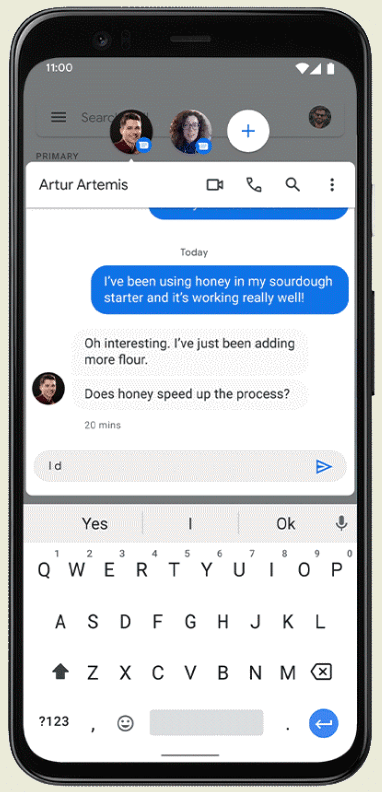
Few days ago Google announced the release of the new version of its mobile platform "Android 11", which for several months had some beta versions (for testing) and since then the system has been refining.
In this new version of Android 11, many related changes have been made in communication as Google wanted to improve the ease of use for people, in addition to the improvements for handling by voice commands, expanded support for 5G, the use of sensors, protection systems and much more.
Communication

On the communication side, in Android 11 it is presented in the drop-down area with notifications, a message summary section, which View and reply to messages from all apps in one place. Important chats can be assigned a priority status so that they are prominently displayed and displayed even in do not disturb mode.
Another important change is that the concept of «bubbles» has been activated, (pop-up dialogs to perform actions in other applications, without exiting the current program).
In addition, the on-screen keyboard implements a contextual suggestion system to quickly reply to messages, offering emojis or typical responses that match the received message.

Networks and Devices
In this category, for this new version of Android 11 we worked to provide a expanded support for the 5G mobile standard. To simplify the adaptation of the work of the application taking into account the 5G communication channels, the Dynamic Meteredness API has been extended, which is used to check if the connection is charged for traffic and if it is possible to transfer large amounts of data through it. This API now covers cellular networks and allows you to define a connection to a provider which provides a truly unlimited rate when connecting over 5G.
The Bandwidth Estimator API has also been expanded, allowing you to predict the amount of bandwidth available for downloading or sending data, without performing your own network tests.
Along with it too an interface was introduced for quick access to control tools for connected devices such as IoT systems, it is called by holding down the power button.
On the part of Wifi, hint API has been improved, which allows the "network connection manager" application influence algorithm to choose preferred wireless networks broadcasting a ranked list of networks and also takes into account additional metrics when choosing a network, such as information about the bandwidth and quality of the communication channel during the previous connection.
Also added the ability to manage wireless networks that support the Hotspot 2.0 standard (Passpoint), including the provision of accounting for user profile expiration time and the ability to use self-signed certificates in profiles.
Security
In Android 11 it was added support for granting unique permissions To allow an application performs a privileged operation once and ask for confirmation again on the next access attempt. For example, it can be configured to ask for credentials every time a microphone, camera, or location API is accessed.
As well the ability to automatically block requested permissions for apps was implemented that haven't been released for more than three months. When locked, a special notification is displayed with a list of apps that haven't been started for a long time, where you can return permissions, delete the app, or leave it locked.
In addition to that they were added new options to control the application's access to personal data. In addition to the way to access the location only while working with the application.
And in the biometric sensors for authentication, its functionality has been expanded With the BiometricPrompt API, which offers a universal biometric authentication dialog, it now supports three types of authenticators: trusted, weak, and device credentials.
Of the other changes that stand out:
- Built-in ability to create screencasts with recording changes to the screen and sound from the microphone.
- Simplified selection of text and images to place on the clipboard and share between applications.
- Updated tools to audit data access.
- Some of the Audit API calls were renamed.
- Added "Ethernet Tethering" mode, which allows Internet access via smartphone to be provided using Ethernet adapters connected via USB port.
- The device's voice control system (Voice Access) has been modernized
- Added "Share Nearby" feature to quickly and securely send files, videos, location data and other information to other nearby devices based on the Android platform or with the Chrome browser.
Finally the sources associated with the new version are in the git repository of the project.
And at the moment firmware updates have been prepared for devices of the series pixel, as well as smartphones from OnePlus, Xiaomi, OPPO, and Realme.
Very good captures and excellent article
I wish you could download an ISO and install it in gnome boxes to test it